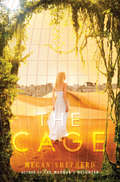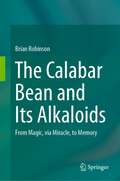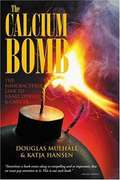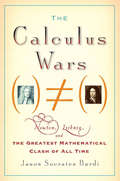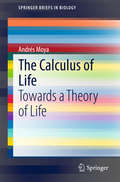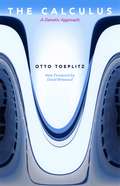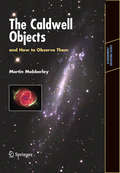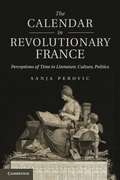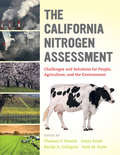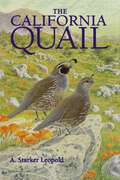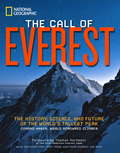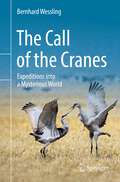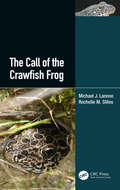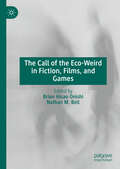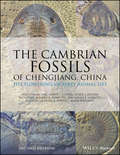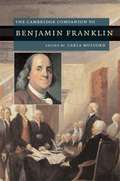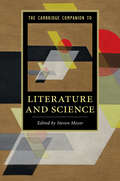- Table View
- List View
The Cadherin Superfamily
by Shintaro T. Suzuki Shinji HiranoThis book presents an overview of the entire field of cadherin research and provides the current basic concept of cadherins. Cadherins have been widely accepted as key regulators of animal development and physiological functions, and it also has become clear that they play essential roles in various human diseases. With contributions by leading scientists, the book covers various aspects of the cadherin superfamily including the history of cadherin research, basic properties of classical cadherins as well as non-classical cadherins, cadherin-associated proteins, and the roles of cadherins in health and diseases. In addition, the book presents some contradictory results and important unanswered questions, and the authors propose their working hypotheses or future directions, to inspire future studies. This volume enables graduate students and young researchers to learn the basics and gain a comprehensive image of the cadherin superfamily, and experts in the field will easily find various topics of interest in relevant areas of study. Additionally, a list of cadherin-related diseases is included for quick reference to cadherins in human diseases.
The Cage
by Megan ShepherdThe Maze Runner meets Scott Westerfeld in this gripping new series about teens held captive in a human zoo by an otherworldly race. From Megan Shepherd, the acclaimed author of The Madman's Daughter trilogy.When Cora Mason wakes in a desert, she doesn't know where she is or who put her there. As she explores, she finds an impossible mix of environments--tundra next to desert, farm next to jungle, and a strangely empty town cobbled together from different cultures--all watched over by eerie black windows. And she isn't alone.Four other teenagers have also been taken: a beautiful model, a tattooed smuggler, a secretive genius, and an army brat who seems to know too much about Cora's past. None of them have a clue as to what happened, and all of them have secrets. As the unlikely group struggles for leadership, they slowly start to trust each other. But when their mysterious jailer--a handsome young guard called Cassian--appears, they realize that their captivity is more terrifying than they could ever imagine: Their captors aren't from Earth. And they have taken the five teenagers for an otherworldly zoo--where the exhibits are humans.As a forbidden attraction develops between Cora and Cassian, she realizes that her best chance of escape might be in the arms of her own jailer--though that would mean leaving the others behind. Can Cora manage to save herself and her companions? And if so . . . what world lies beyond the walls of their cage?
The Calabar Bean and its Alkaloids: From Magic, via Miracle, to Memory
by Brian RobinsonInvestigations into Calabar beans (the dried ripe seeds of Physostigma venenosum) and their alkaloidal components compose a classical scientific journey throughout some one-and-a-half centuries and not only represent a fascinating aspect of the history of medicine but which is, moreover, still ongoing at the forefront of chemical and medical discovery. Those in particular involving its major such component, l-physostigmine, have led to an understanding of some of the fundamental mechanisms occurring in physiology, pharmacology and biochemistry and, either actually or potentially (by providing a template and thereby acting as a “lead compound”) have provided a useful treatment for a variety of neurological disorders associated with irregularities in cholinergic transmission in which augmentation of cholinergic activity has proved to be beneficial.
The Calcium Bomb: The Nanobacteria Link to Heart Disease & Cancer
by Katja Hansen Douglas MulhallThis book explores research into the calcification that occurs in the human body. It describes the findings of researchers in several countries and presents an overview of how calcification impacts heart disease and cancer. The book is written in plain English in order to be accessible to both patients and their doctors.
The Calcium Connection: The Little-Known Enzyme at the Root of Your Cellular Health
by Brunde BroadyDid you know that one single enzyme impacts your odds of contracting most deadly diseases and health conditions? An enormous body of reputable research into this enzyme has been isolated, ignored, and misunderstood by medical experts. The importance of this enzyme simply cannot be overstated.The Calcium Connection: The Little-Known Enzyme at the Root of Your Cellular Health delivers a clear explanation of this enzyme&’s function and outlines the steps you can take to gain optimal enzyme health. The accessible, information-packed format teaches you all about Calcium ATPase: how it works, what happens when it goes awry, and easy, practical methods to bring it back into balance and protect it—and your overall health. Whether you&’re a health enthusiast, environmentalist, parent, or just want to be better informed, this book will help you boost your health now and into the future. Brunde Broady recounts her tireless quest to find a cure for her son Knute&’s compromised health since being whisked away and kept in ICU after birth. The medical establishment could only help manage his condition, but not diagnose or cure him. Doing her own research and documenting everything Knute ate and his reactions to certain foods, she came across two ubiquitous food additives. Diving deeper, she learned how Calcium ATPase, a fundamental regulator of intercellular calcium, is negatively impacted, not only by these additives, but by a torrent of other inhibitors. Knute&’s health is a testament to Brunde&’s discoveries, and The Calcium Connection gives readers a front-row seat to understanding how to maintain optimized cellular health.
The Calculus Wars: Newton, Leibniz, and the Greatest Mathematical Clash of All Time
by Jason Socrates BardiThis vibrant and gripping history ultimately exposes how these twin mathematical giants (Newton, Leibniz) were proud, brilliant, at times mad, and in the end completely human.
The Calculus of Life
by Andrés MoyaThis book explores the exciting world of theoretical biology and is divided into three sections. The first section examines the roles played by renowned scientists such as Jacob, Monod, Rosen, Turing, von Bertalanffy, Waddington and Woodger in developing the field of theoretical biology. The second section, aided with numerous examples, supports the idea that logic and computing are suitable formal languages to describe and understand biological phenomena. The third and final section is, without doubt, the most intellectually challenging and endeavors to show the possible paths we could take to compute a cell - the basic unit of life - or the conditions required for a predictive theory of biological evolution; ultimately, a theory of life in the light of modern Systems Biology. The work aims to show that modern biology is closer than ever to making Goethe's dream come true and that we have reached a point where synthetic and analytical traditions converge to shed light on the living being as a whole.
The Calculus: A Genetic Approach
by Otto ToeplitzWhen first published posthumously in 1963, this bookpresented a radically different approach to the teaching of calculus. In sharp contrast to the methods of his time, Otto Toeplitz did not teach calculus as a static system of techniques and facts to be memorized. Instead, he drew on his knowledge of the history of mathematics and presented calculus as an organic evolution of ideas beginning with the discoveries of Greek scholars, such as Archimedes, Pythagoras, and Euclid, and developing through the centuries in the work of Kepler, Galileo, Fermat, Newton, and Leibniz. Through this unique approach, Toeplitz summarized and elucidated the major mathematical advances that contributed to modern calculus. Reissued for the first time since 1981 and updated with a new foreword, this classic text in the field of mathematics is experiencing a resurgence of interest among students and educators of calculus today.
The Caldwell Objects and How to Observe Them
by Martin MobberleyThe Messier's catalog of 109 'non-stellar' objects is still used by amateur astronomers as a guide to interesting objects to view and image. In 1995 the notable English astronomer and broadcaster Sir Patrick Moore published his own catalog of a further 109 objects, to complement the Messier catalog and provide an extended list of fascinating targets for amateur astronomers. He called it the Caldwell Catalog (Sir Patrick's full name is Patrick Alfred Caldwell-Moore), the 'M' designation having already been used by Messier. Some of the objects included are Caldwell 11 (The Bubble Nebula), spiral galaxy Calwell 30, and Caldwell 49 and 50 (The Rosette Nebulae). Along with Messier's list and Herschel's list of mostly faint 'non-stellar' objects, the Caldwell objects are now programmed into many automated telescope controllers. This allows all of these objects to be located easily even by newcomer astronomers. The Caldwell objects are just as spectacular as the 'M' objects, especially when using the large telescopes and the sensitive CCD cameras readily available today. The Caldwell Objects and How to Observe Them comprehensively describes all of the 109 Caldwell objects, with specific advice on how to find them (if necessary with a 'Go-To' telescope), how to visually observe or image them, and how to image-process the results. There is information about the optimum astronomical equipment to use for each object and, for those who prefer to make sketches, there is advice on drawing these extended objects at the eyepiece.
The Calendar in Revolutionary France: Perceptions of Time in Literature, Culture, Politics
by Sanja PerovicOne of the most unusual decisions of the leaders of the French Revolution - and one that had immense practical as well as symbolic impact - was to abandon customarily-accepted ways of calculating date and time to create a Revolutionary calendar. The experiment lasted from 1793 to 1805, and prompted all sorts of questions about the nature of time, ways of measuring it and its relationship to individual, community, communication and creative life. This study traces the course of the Revolutionary Calendar, from its cultural origins to its decline and fall. Tracing the parallel stories of the calendar and the literary genius of its creator, Sylvain Maréchal, from the Enlightenment to the Napoleonic era, Sanja Perovic reconsiders the status of the French Revolution as the purported 'origin' of modernity, the modern experience of time, and the relationship between the imagination and political action.
The California Nitrogen Assessment: Challenges and Solutions for People, Agriculture, and the Environment
by Thomas P. TomichNitrogen is indispensable to all life on Earth. However, humans now dominate the nitrogen cycle, and nitrogen emissions from human activity have real costs: water and air pollution, climate change, and detrimental effects on human health, biodiversity, and natural habitats. Too little nitrogen limits ecosystem processes, while too much nitrogen transforms ecosystems profoundly. The California Nitrogen Assessment is the first comprehensive account of nitrogen flows, practices, and policies for California, encompassing all nitrogen flows--not just those associated with agriculture--and their impacts on ecosystem services and human wellbeing. How California handles nitrogen issues will be of interest nationally and internationally, and the goal of the assessment is to link science with action and to produce information that affects both future policy and solutions for addressing nitrogen pollution. This book also provides a model for application of integrated ecosystem assessment methods at regional and state (subnational) levels.
The California Quail
by A. Starker LeopoldWe all recognize the California Quail, with its striking good looks and mellow call notes. Widely distributed along the whole Pacific Coast, it has long been of interest to bird-lovers, sportsmen, ranchers, and wildlife biologists. In early times it was an important food source, and stocks were rapidly depleted by market hunters. Today its populations are being restored through the efforts of both private land-owners and government agencies. This comprehensive report summarizes what is known about the history, biology, and management of the species. It recounts the impact of settlement on quail, it describes the quail's intriguing social life, covey relationships, nesting behavior, and habitat requirements. Males, for example, play an important role in chick-rearing; chemical compounds in food substantially influence the nesting success of females. A major part of this book tells how to provide proper over, food, and drinking water that are needed to increase quail populations, whether for hunting or for observation and enjoyment. The suggestions offered stem from decades of scientific research and practical management effort. Written by a renowned wildlife biologist who worked on the quail for many years, this volume will be the definitive work from both the natural history and game management points of view. It is copiously illustrated with photographs and drawings, and will be of use to anyone who wishes to understand and foster the state bird.
The Call of Everest: The History, Science, and Future of the World's Tallest Peak
by Conrad Anker Thomas HornbeinIn 1963, the American Mount Everest Expedition made mountaineering history. It was the first American venture to successfully scale the legendary peak and the first successful climb up the hazardous West Ridge (a climb so difficult no one has yet repeated it). In 2012, adventurer Conrad Anker led a National Geographic/The North Face team up the mountain to enact a legacy climb. Environmental changes and overcrowding led to challenges and disappointments, but yet the mountain maintains its allure. Now, steely-eyed Anker leads a team of writers in a book designed to celebrate the world's most famous mountain, to look back over the years of climbing triumphs and tragedies, and to spotlight what has changed - and what remains eternal - on Mount Everest. Telltale signs of Everest's current state, never-before-published photography, and cutting-edge science expose the world's tallest peak - its ancient meaning, its ever-present challenges, and its future in a world of disappearing ice.
The Call of the Cranes: Expeditions into a Mysterious World
by Bernhard WesslingCranes are enigmatic birds. Only very little is known about the behaviour of these graceful dancers. The renowned naturalist and crane expert Bernhard Wessling takes us on exciting and adventurous expeditions into their hidden world and gets to the bottom of the myths surrounding these birds of happiness. With the help of a specially developed bioacoustic method, Dr. Wessling studied Eurasian, Red-Crowned, Sandhill and Whooping Cranes, all in the wild. He has researched their intelligence, social dynamics and communication and engaged in their protection. Impressively illustrated and lively narrated, this book presents his findings on their individually unique lives and relationships, their ability to adapt and solve problems, and their emotions. His observations allow us to delve deeply into the cranes' way of life and consciousness, often demonstrating the surprising similarities between humans and animals. An amazing work about the spirit of discovery, humility and respect for nature in the tradition of Alexander von Humboldt.Cranes are among the most captivating birds on this planet. Dr. Wessling knows these birds, has accumulated a lifetime of observations on them, and has thought deeply about their abilities. In this book, he seeks to overturn old ideas about how these birds live, communicate, and think. His revelations surprise and delight and shed new light on an ancient avian family. Jennifer Ackerman, author of the New York Times bestseller The Genius of Birds and The Bird WayThe Call of the Cranes is a mesmerizing, vivid, lyrical and revelatory book. It truly is a spectacular book and a treasure! Sy Montgomery, naturalist and author of 31 books (incl. the New York Times bestseller The Soul of an Octopus: A Surprising Exploration into the Wonder of Consciousness)In this book, Bernhard Wessling shares his fascinating stories about cranes through patient observations and thoughtful conclusions. George Archibald, Co-Founder of the International Crane Foundation, Senior Conservationist
The Call of the Crawfish Frog
by Michael J. Lannoo Rochelle M. StilesCrawfish Frogs (Rana areolata) have been called the most secretive frog in North America, and it is unusual in the twenty-first century – in the most scientifically advanced country in the world – that basic discoveries can still be made on an animal that inhabits a quarter of the United States. This is not only a story of the biology of Crawfish Frogs, but a case study of discovery. This volume describes the life history and natural history critical to the survival of the endangered amphibian and recommends management actions to ensure persistence. The authors tell an optimistic conservation biology story and fill a gap between science and the public. The authors have compiled and summarized the peer-reviewed literature on the biology of Crawfish Frogs, which may be one of the most interesting frogs in North America (that nobody knows about). Key Features Recounts the story of an imperiled species and how to go about saving it Vividly brings science to life and makes it accessible Provides a popular account of natural history research and ecological fieldwork Related Titles D. Vieira de Andrade, C. R. Bevier & J. Eduardo de Carvalho, eds. Amphibian and Reptile Adaptations to the Environment: Interplay Between Physiology and Behavior (ISBN 978-1-4822-2204-3). M. Ogielska, ed. Reproduction of Amphibians (ISBN 978-1-1381-1771-6). D. W. Sparling, G. Linder, C. A. Bishop & S. Krest, eds. Ecotoxicology of Amphibians and Reptiles, 2nd Edition (ISBN 978-1-4200-6416-2). F. L. Frye. Reptiles and Amphibians: Self-Assessment Color Review, Second Edition (ISBN 978-1-4822-5760-1).
The Call of the Eco-Weird in Fiction, Films, and Games
by Brian Hisao Onishi Nathan M. BellThis edited volume identifies and analyses the Eco-Weird as an interdisciplinary theoretical tool for engaging in fictional, philosophical, filmic, and ludic texts. It is the first volume to engage in the study of the Eco-Weird, which is a developing field at the intersection of environmental thought and Weird fiction, broadly construed to include literature, games, films, art, and television shows. The Eco-Weird has intersections with other literary and scholarly fields, including horror studies, game studies, phenomenology, literary criticism, and eco-criticism, but provides a unique set of tools to engage both its texts and the ongoing environmental crises of climate change, environmental justice, pollution, and more.
The Call of the Osprey (Scientists in the Field Series)
by Dorothy Hinshaw Patent William MuñozThis meticulously researched and photographed account follows three University of Montana scientists and their interdisciplinary work with osprey: fish-catching birds with gigantic nests and a family that functions with teamwork and cooperation. Today the osprey is studied to monitor the effects of mercury on living things. The osprey hunts in a very small area around its large nest and so scientists can pinpoint where mercury is coming from. In Missoula, Montana, the scientists have been following ospreys for six years, collecting data on the amount of contaminants found on their feathers and in their blood. The rivers and streams in Western Montana are still suffering effects from inappropriate mining activities performed more than a hundred years ago. This man-made pollution is still dangerous to people and to wildlife.
The Cambrian Fossils of Chengjiang, China: The Flowering of Early Animal Life
by Mark Williams Cong Pei-Yun David J. Siveter Derek J. Siveter Hou Xian-Guang Ma Xiao-Ya Mark A. Purnell Richard J. Aldridge Sarah E. GabbottThe celebrated lower Cambrian Chengjiang biota of Yunnan Province, China, represents one of the most significant ever paleontological discoveries. Deposits of ancient mudstone, about 520 million years old, have yielded a spectacular variety of exquisitely preserved fossils that record the early diversification of animal life. Since the discovery of the first specimens in 1984, many thousands of fossils have been collected, exceptionally preserving not just the shells and carapaces of the animals, but also their soft tissues in fine detail. This special preservation has produced fossils of rare beauty; they are also of outstanding scientific importance as sources of evidence about the origins of animal groups that have sustained global biodiversity to the present day. Much of the scientific documentation of the Chengjiang biota is in Chinese, and the first edition of this book was the first in English to provide fossil enthusiasts with a comprehensive overview of the fauna. The second edition has been fully updated and includes a new chapter on other exceptionally preserved fossils of Cambrian age, exciting new fossil finds from Chengjiang, and a phylogenetic framework for the biota. Displaying some 250 figures of marvelous specimens, this book presents to professional and amateur paleontologists, and all those fascinated by evolutionary biology, the aesthetic and scientific quality of the Chengjiang fossils.
The Cambridge Atlas of Herschel Objects
by James Mullaney Wil TirionThis superb, all-purpose star atlas is the first of its kind devoted to observing the Herschel objects with binoculars and telescopes. It displays over 2500 of the most visually-attractive star clusters, nebulae and galaxies that were discovered by Sir William, Caroline and Sir John Herschel, and is a must-have for stargazers who want to explore these fascinating objects. Covering the entire sky from the North to the South Celestial Pole, and showing all 88 constellations, it is also a general sky atlas showing variable, double and multiple stars, and the Milky Way. Written by experienced observer James Mullaney and illustrated by renowned celestial cartographer Wil Tirion, this is a magnificent 'celestial roadmap' to some of the finest deep-sky showpieces. Spiral bound and printed in red-light friendly colors for use at a telescope, with color-coded symbols for easy recognition and identification, this is an all-purpose observing reference for all amateur observers.
The Cambridge Companion to Benjamin Franklin
by Carla MulfordComprehensive and accessible, this Companion addresses several well-known themes in the study of Franklin and his writings, while also showing Franklin in conversation with his British and European counterparts in science, philosophy, and social theory. Specially commissioned chapters, written by scholars well-known in their respective fields, examine Franklin's writings and his life with a new sophistication, placing Franklin in his cultural milieu while revealing the complexities of his intellectual, literary, social, and political views. Individual chapters take up several traditional topics, such as Franklin and the American dream, Franklin and capitalism, and Franklin's views of American national character. Other chapters delve into Franklin's library and his philosophical views on morality, religion, science, and the Enlightenment and explore his continuing influence in American culture. This Companion will be essential reading for students and scholars of American literature, history and culture.
The Cambridge Companion to Darwin
by Jonathan Hodge Gregory RadickThe naturalist and geologist Charles Darwin (1809-82) ranks as one of the most influential scientific thinkers of all time. In the nineteenth century his ideas about the history and diversity of life - including the evolutionary origin of humankind - contributed to major changes in the sciences, philosophy, social thought and religious belief. This volume provides the reader with clear, lively and balanced introductions to the most recent scholarship on Darwin and his intellectual legacies. A distinguished team of contributors examines Darwin's main scientific ideas and their development; Darwin's science in the context of its times; the influence of Darwinian thought in recent philosophical, social and religious debate; and the importance of Darwinian thought for the future of naturalist philosophy. New readers will find this a most convenient and accessible guide to Darwin. Advanced students and specialists will find a conspectus of recent developments in the interpretation of Darwin.
The Cambridge Companion to Einstein
by Michel Janssen Christoph LehnerThis volume is the first systematic presentation of the work of Albert Einstein, comprising fourteen essays by leading historians and philosophers of science that introduce readers to his work. Following an introduction that places Einstein's work in the context of his life and times, the book opens with essays on the papers of Einstein's 'miracle year', 1905, covering Brownian motion, light quanta, and special relativity, as well as his contributions to early quantum theory and the opposition to his light quantum hypothesis. Further essays relate Einstein's path to the general theory of relativity (1915) and the beginnings of two fields it spawned, relativistic cosmology and gravitational waves. Essays on Einstein's later years examine his unified field theory program and his critique of quantum mechanics. The closing essays explore the relation between Einstein's work and twentieth-century philosophy, as well as his political writings.
The Cambridge Companion to Galileo
by Peter MachamerNot only a hero of the scientific revolution, but after his conflict with the church, a hero of science, Galileo is today rivalled in the popular imagination only by Newton and Einstein. But what did Galileo actually do, and what are the sources of the popular image we have of him? This collection of specially-commissioned essays is unparalleled in the depth of its coverage of all facets of Galileo's work. A particular feature of the volume is the treatment of Galileo's relationship with the church. It will be of interest to philosophers, historians of science, cultural historians and those in religious studies.
The Cambridge Companion to Literature and Science (Cambridge Companions To Literature )
by Steven MeyerIn 1959, C. P. Snow lamented the presence of 'two cultures': the unbridgeable chasm of understanding, and knowledge between modern literature and modern science. Over the past twenty years, scholars in literature and science studies have worked diligently to interrogate relations between twentieth- and twenty-first-century literature and science as radically alienated from each other. <P><P>The Cambridge Companion to Literature and Science offers a roadmap to developments which have contributed to the emergence of reciprocal connections between the two areas of study. Weaving together theory and empiricism, individual chapters explore major figures - Shakespeare, Bacon, Darwin, Henry James, William James, Einstein; major genres - fiction, science fiction, poetry, dramatic works, science studies; and major theories and movements - pragmatism, critical theory, cognitive science, ecocriticism, cultural studies, affect theory, digital humanities, and empiricism. This book will be a key resource for scholars, graduate students, and undergraduate students alike.<P> Offers a new understanding of literature and science that demonstrates how an entire field of study has changed in recent decades as well as what the basis of that change is.<P> Describes the extensive overlap of literature and science with science studies, showing that the former is by no means just a subfield of the latter.<P> Promotes the integration of elements in the contemporary world that are often taken to be opposed, allowing readers to understand the limitations and imprecision of frequent claims for a literature/science ('two cultures') dichotomy.
The Cambridge Companion to Newton
by Smith George E. Rob IliffeSir Isaac Newton (1642–1727) was one of the greatest scientists of all time, a thinker of extraordinary range and creativity who has left enduring legacies in mathematics and physics. While most famous for his Principia, his work on light and colour, and his discovery of the calculus, Newton devoted much more time to research in chemistry and alchemy, and to studying prophecy, church history and ancient chronology. This new edition of The Cambridge Companion to Newton provides authoritative introductions to these further dimensions of his endeavours as well as to many aspects of his physics. It includes a revised bibliography, a new introduction and six new chapters: three updating previous chapters on Newton's mathematics, his chemistry and alchemy and the reception of his religious views; and three entirely new, on his religion, his ancient chronology and the treatment of continuous and discontinuous forces in his second law of motion.

